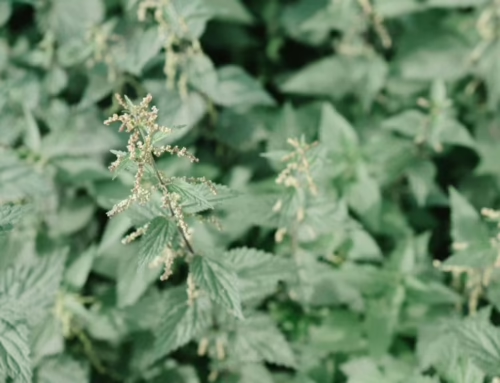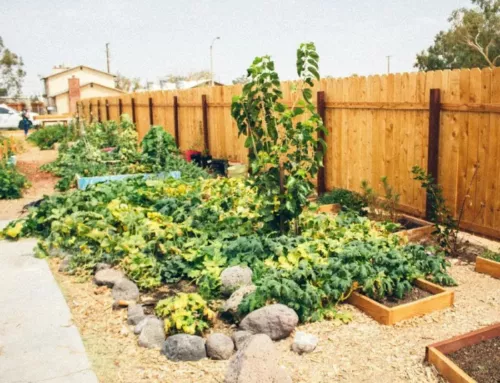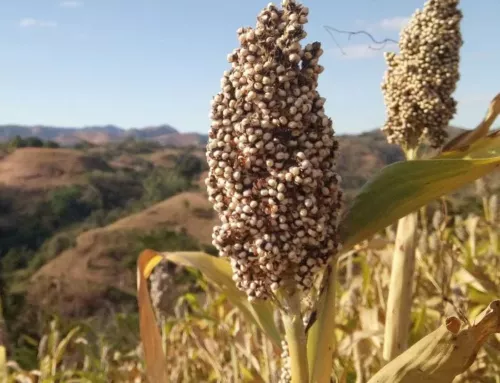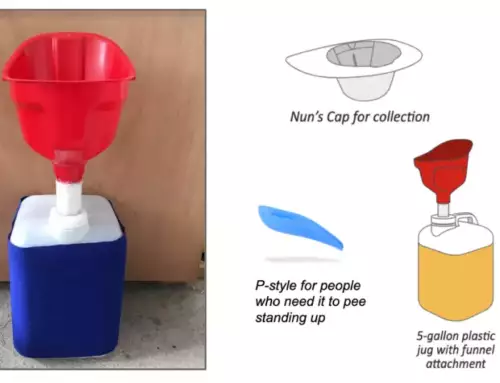By Ophelia Jackson, Gardener and NOFA/Mass Intern
Listen to a recording of this article by the author
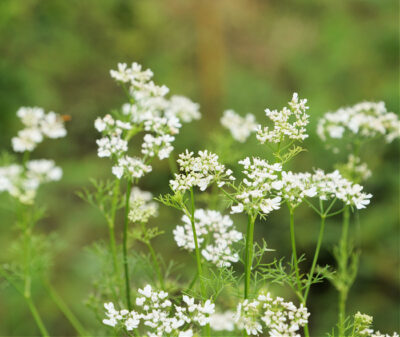
Flowering cilantro
Summer in the garden is a heady season, a season of smells—the rich petrichor after afternoon thunderstorms and the fine good stink of a compost pile in the sun; sweet basil, fresh pesto—and cilantro’s sharp green tang.
It’s true that few gardeners think of cilantro as a summer crop; growing best in cool, moist conditions, it is usually planted in early spring or early fall. By June, ours, too, is clearly past its prime. A leggy, flowering tangle now long since gone to seed, it’s barely recognizable as the trim, leafy herb of earlier months. Really, what it looks like most is a weed. But it’s no mistake that we haven’t pulled it yet.
There are a variety of planting and harvesting practices gardeners can implement to prolong their cilantro harvest as the weather warms. (See below for some tips for this.) Ultimately, of course, it will still bolt sooner or later. But given the opportunity, this provides a harvest of its flowers and seeds—both of which boast a variety of uses. It’s worth considering whether the plants might still merit a spot in the garden a little while longer.
Delaying Bolting
Bolting is a survival mechanism initiated at the end of the cilantro plant’s life cycle, when the plant concentrates its energy to produce seeds and ensure the next generation survives beyond the existing one that will die in the heat. Because cilantro is sensitive to ground—not air—temperatures, mulching beds and planting tightly for shade can keep the surrounding soil cool and moist, thereby delaying bolting even as the days warm. Succession planting, or staggering the starting of seeds across multiple sowings over a period of time, can also extend the yield, with younger plants continuing to produce even after older ones have already gone to seed. Regularly cutting leaves, growing cilantro in partial shade, or selecting slow-bolting varieties can also help lengthen the harvest.
Harvesting Flowers
Once cilantro bolts, it is still possible to cut or harvest the flowers. The lacey, starlike white blossoms can serve not only to decorate the table, but also the meal itself. Edible, with a slightly milder flavor and fragrance than its leaves, cilantro flowers add both savor and beauty in salads, or can be used as a distinctive garnish for many dishes.
Harvesting Seeds
After the cilantro plant flowers, it forms small, round seeds which gradually turn from green to brown. When this occurs, they can be harvested and dried for later use in a dehydrator, or in paper bags or on newspaper indoors. In cooking, cilantro seeds are known as the spice coriander, which has warm, earthy, nutty, and citrusy flavors, and can be used in a variety of Asian, Latin, and Indian dishes. Of course, the dried seeds can also be saved to start the next year’s crop.
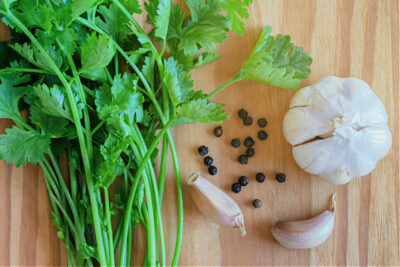
Left to right: Fresh cilantro leaves, cilantro seeds, garlic cloves.
The Value of Late-Season Cilantro
Cilantro can be a polarizing and controversial garnish. In mixed company, it’s often best reserved until just before the meal—quarantined for individual application by only those who choose to partake. For enthusiasts, though, the only real question is how to get the most from our cilantro harvest, and we can do this both by optimizing the timing, location, and variety of cultivation, as well as exploring the many uses of its flowers and seeds—on the table, in the kitchen, and for the next year’s garden—after the original plants have gone to seed.
Regardless of one’s individual cilantro orientation, though, to me its smell in June also represents some of the most valuable lessons the garden has to offer us all; how to keep a thing and when to let it go. As gardeners, we must cultivate the humility to surrender to each crop and each season’s passing—but also the patient resourcefulness to waste nothing, to find bounty even in its waning and embrace a harvest other than the one for which we sowed.
Because cilantro blooms only as it is nearing the end of its life cycle, harvesting its flowers offers us the opportunity to celebrate this dainty grace in the face of mortality and decline. Because it goes to seed during the lengthening daylight of late spring and early summer, when the sun is at its zenith and life in the garden is in many other ways nearing its peak; cilantro invites us to reflect on the garden’s fundamental rhythms of growth and decay, not as opposite but inextricable—simultaneous, parallel, perennial, unfolding around us all the time.
Resources:
https://www.creativevegetablegardener.com/cilantro-bolting/
https://www.gardeningknowhow.com/edible/herbs/cilantro/cilantro-bolting.htm
https://sowtrueseed.com/blogs/gardening/cilantro-let-it-bolt
https://www.thespruceeats.com/cilantro-vs-coriander-695294
About the author:

Ophelia Jackson is a student at Oberlin College and grew up in Tallahassee, Florida. She is an artist, writer, gardener, and home kombucha brewer.

